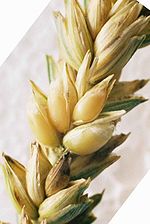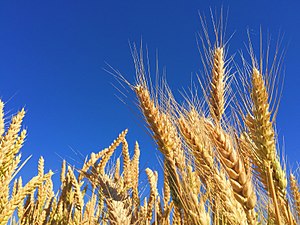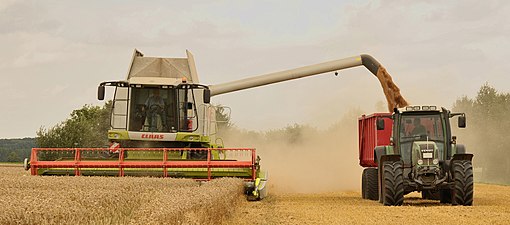Wheat
| Wheat | |
|---|---|

| |
| Scientific classification | |
| Kingdom: | Plantae |
| Clade: | Tracheophytes |
| Clade: | Angiosperms |
| Clade: | Monocots |
| Clade: | Commelinids |
| Order: | Poales |
| Family: | Poaceae |
| Subfamily: | Pooideae |
| Tribe: | Triticeae |
| Genus: | Triticum L.[1] |
| Type species | |
Triticum aestivum | |
| Species[2] | |
|
List of Triticum species:
| |
Wheat is a grass widely cultivated for its seed, a cereal grain that is a worldwide staple food. The many species of wheat together make up the genus Triticum (/ˈtrɪtɪkəm/);[3] the most widely grown is common wheat (T. aestivum). The archaeological record suggests that wheat was first cultivated in the regions of the Fertile Crescent around 9600 BC. Botanically, the wheat kernel is a caryopsis, a type of fruit.
Wheat is grown on more land area than any other food crop (220.7 million hectares or 545 million acres in 2021). World trade in wheat is greater than for all other crops combined. In 2021, world wheat production was 771 million tonnes (850 million short tons), making it the second most-produced cereal after maize (known as corn in the US and Australia; wheat is often called corn in other countries). Since 1960, world production of wheat and other grain crops has tripled and is expected to grow further through the middle of the 21st century. Global demand for wheat is increasing because of the usefulness of gluten to the food industry.
Wheat is an important source of
Description

Wheat is a stout grass of medium to tall height. Its stem is jointed and usually hollow, forming a straw. There can be many stems on one plant. It has long narrow leaves, their bases sheathing the stem, one above each joint. At the top of the stem is the flower head, containing some 20 to 100 flowers. Each flower contains both male and female parts. The flower, which is
Leaves emerge from the shoot apical
Wheat
Depending on variety, wheat may be awned or not awned. Producing awns incurs a cost in grain number,[15] but wheat awns photosynthesise more efficiently than their leaves with regards to water usage,[16] so awns are much more frequent in varieties of wheat grown in hot drought-prone countries than those generally seen in temperate countries. For this reason, awned varieties could become more widely grown due to climate change. In Europe, however, a decline in climate resilience of wheat has been observed.[17]
History

Domestication
Repeated harvesting and sowing of the grains of
Wild
Wild
Early farming

Einkorn and emmer are considered two of the founder crops cultivated by the first farming societies in Neolithic West Asia.[25] These communities also cultivated naked wheats (T. aestivum and T. durum) and a now-extinct domesticated form of Zanduri wheat (T. timopheevii),[30] as well as a wide variety of other cereal and non-cereal crops.[31] Wheat was relatively uncommon for the first thousand years of the Neolithic (when barley predominated), but became a staple after around 8500 BC.[31] Early wheat cultivation did not demand much labour. Initially, farmers took advantage of wheat's ability to establish itself in annual grasslands by enclosing fields against grazing animals and re-sowing stands after they had been harvested, without the need to systematically remove vegetation or till the soil.[32] They may also have exploited natural wetlands and floodplains to practice décrue farming, sowing seeds in the soil left behind by receding floodwater.[33][34][35] It was harvested with stone-bladed sickles.[36] The ease of storing wheat and other cereals led farming households to become gradually more reliant on it over time, especially after they developed individual storage facilities that were large enough to hold more than a year's supply.[37]
Wheat grain was stored after
Spread
Domestic wheat was quickly spread to regions where its wild ancestors did not grow naturally. Emmer was introduced to Cyprus as early as 8600 BC and einkorn c. 7500 BC;[43][44] emmer reached Greece by 6500 BC, Egypt shortly after 6000 BC, and Germany and Spain by 5000 BC.[45] "The early Egyptians were developers of bread and the use of the oven and developed baking into one of the first large-scale food production industries."[46] By 4000 BC, wheat had reached the British Isles and Scandinavia.[47][48][49] Wheat likely appeared in China's lower Yellow River around 2600 BC.[50]
The oldest evidence for
-
Sumerian cylinder seal impression dating to c. 3200 BC showing an ensi and his acolyte feeding a sacred herd wheat stalks; Ninurta was an agricultural deity and, in a poem known as the "Sumerian Georgica", he offers detailed advice on farming
-
Threshing of wheat in ancient Egypt
-
Traditional wheat harvesting in Madhya Pradesh, 2012
Evolution
Phylogeny

Some wheat species are
A 2007 molecular phylogeny of the wheats gives the following not fully-resolved cladogram of major cultivated species; the large amount of hybridisation makes resolution difficult. Markings like "6N" indicate the degree of polyploidy of each species:[57]
| Triticeae |
| ||||||||||||||||||||||||||||||||||||||||||
Taxonomy
During 10,000 years of cultivation, numerous forms of wheat, many of them
Major species
Hexaploid species (6N)
- Common wheat or bread wheat (T. aestivum) – The most widely cultivated species in the world.[63]
- Spelt (T. spelta) – Another species largely replaced by bread wheat, but in the 21st century grown, often organically, for artisanal bread and pasta.[64]
Tetraploid species (4N)
- Durum (T. durum) – A wheat widely used today, and the second most widely cultivated wheat.[63]
- Emmer (T. turgidum subsp. dicoccum and T. t. conv. durum) – A species cultivated in ancient times, derived from wild emmer, T. dicoccoides, but no longer in widespread use.[65]
- Khorasan or Kamut (T. turgidum ssp. turanicum, also called T. turanicum) is an ancient grain type; Khorasan is a historical region in modern-day Afghanistan and the northeast of Iran. The grain is twice the size of modern wheat and has a rich nutty flavor.[66]
Diploid species (2N)
- Einkorn (T. monococcum). Domesticated from wild einkorn, T. boeoticum, at the same time as emmer wheat.[67]
Hulled versus free-threshing species
The four wild species of wheat, along with the domesticated varieties
As a food
Naming of grain classes
Wheat grain classes are named by color, season, and hardness.[72] The classes used in the United States are:[73][74]
- Hard Red Spring – Hard, brownish, high-protein wheat used for bread and hard baked goods. Bread flour and high-gluten flours are commonly made from hard red spring wheat. It is primarily traded on the Minneapolis Grain Exchange.[73][74]
- Hard Red Winter – Hard, brownish, mellow high-protein wheat used for bread, hard baked goods and as an adjunct in other flours to increase protein in pastry flour for pie crusts. Some brands of unbleached all-purpose flours are commonly made from hard red winter wheat alone. It is primarily traded on the Mennonite immigrants from Russia.[73][74][75] Marquis wheat was developed to prosper in the shorter growing season in Canada, and is grown as far south as southern Nebraska.[76]
- Soft Red Winter – Soft, low-protein wheat used for cakes, pie crusts, biscuits, and self-rising flours with baking powder and salt added, for example, are made from soft red winter wheat. It is primarily traded on the Chicago Board of Trade.[73][74]
- Hard White – Hard, light-colored, opaque, chalky, medium-protein wheat planted in dry, temperate areas. Used for bread and brewing.[73][74]
- Soft White – Soft, light-colored, very low protein wheat grown in temperate moist areas. Used for pie crusts and pastry.[73][74]
Food value and uses

| Nutritional value per 100 g (3.5 oz) | |
|---|---|
| Energy | 1,368 kJ (327 kcal) |
71.18 g | |
| Sugars | 0.41 |
| Dietary fiber | 12.2 g |
1.54 g | |
12.61 g | |
Niacin (B3) | 34% 5.464 mg |
| Pantothenic acid (B5) | 19% 0.954 mg |
| Vitamin B6 | 18% 0.3 mg |
| Folate (B9) | 10% 38 μg |
| Choline | 6% 31.2 mg |
| Vitamin E | 7% 1.01 mg |
| Vitamin K | 2% 1.9 μg |
| Minerals | Quantity %DV† |
| Calcium | 2% 29 mg |
| Iron | 18% 3.19 mg |
| Magnesium | 30% 126 mg |
| Manganese | 173% 3.985 mg |
| Phosphorus | 23% 288 mg |
| Potassium | 12% 363 mg |
| Sodium | 0% 2 mg |
| Zinc | 24% 2.65 mg |
| Other constituents | Quantity |
| Water | 13.1 g |
| Selenium | 70.7 µg |
| †Percentages estimated using US recommendations for adults,[77] except for potassium, which is estimated based on expert recommendation from the National Academies.[78] | |
Wheat is a staple cereal worldwide.
Nutrition
Raw red winter wheat is 13% water, 71%
Wheat is a significant source of
Health advisories
Consumed worldwide by billions of people, wheat is a significant food for human nutrition, particularly in the least developed countries where wheat products are primary foods.[84][91] When eaten as the whole grain, wheat supplies multiple nutrients and dietary fiber recommended for children and adults.[83][84][92][93] In genetically susceptible people, wheat gluten can trigger
Production and consumption
Global
| Country | Millions of tonnes |
|---|---|
| 137.7 | |
| 107.7 | |
| 104.2 | |
| 44.9 | |
| 36.2 | |
| 34.6 | |
| 34.3 | |
| World | 808.4 |
| Source: UN Food and Agriculture Organization[102]
| |
-
Wheat-growing areas of the world
-
Production of wheat (2019)[103]
-
Wheat's share (brown) of world crop production fell in the 21st century.
In 2022, world wheat production was 808.4 million tonnes, led by China, India, and Russia which collectively provided 43.22% of the world total.[104] As of 2019[update], the largest exporters were Russia (32 million tonnes), United States (27), Canada (23) and France (20), while the largest importers were Indonesia (11 million tonnes), Egypt (10.4) and Turkey (10.0).[105] In 2021, wheat was grown on 220.7 million hectares or 545 million acres worldwide, more than any other food crop.[106] World trade in wheat is greater than for all other crops combined.[107] Global demand for wheat is increasing due to the unique
Historical factors

Wheat became a central agriculture endeavor in the worldwide British Empire in the 19th century, and remains of great importance in Australia, Canada and India.[110] In Australia, with vast lands and a limited work force, expanded production depended on technological advances, especially regarding irrigation and machinery. By the 1840s there were 900 growers in South Australia. They used "Ridley's Stripper", to remove the heads of grain, a reaper-harvester perfected by John Ridley in 1843.[111] In Canada, modern farm implements made large scale wheat farming possible from the late 1840s. By 1879, Saskatchewan was the center, followed by Alberta, Manitoba and Ontario, as the spread of railway lines allowed easy exports to Britain. By 1910, wheat made up 22% of Canada's exports, rising to 25% in 1930 despite the sharp decline in prices during the worldwide Great Depression.[112] Efforts to expand wheat production in South Africa, Kenya and India were stymied by low yields and disease. However, by 2000 India had become the second largest producer of wheat in the world.[113] In the 19th century the American wheat frontier moved rapidly westward. By the 1880s 70% of American exports went to British ports. The first successful grain elevator was built in Buffalo in 1842.[114] The cost of transport fell rapidly. In 1869 it cost 37 cents to transport a bushel of wheat from Chicago to Liverpool. In 1905 it was 10 cents.[115]
In the 20th century, global wheat output expanded by about 5-fold, but until about 1955 most of this reflected increases in wheat crop area, with lesser (about 20%) increases in crop yields per unit area. After 1955 however, there was a ten-fold increase in the rate of wheat yield improvement per year, and this became the major factor allowing global wheat production to increase. Thus technological innovation and scientific crop management with synthetic nitrogen fertilizer, irrigation and wheat breeding were the main drivers of wheat output growth in the second half of the century. There were some significant decreases in wheat crop area, for instance in North America.[116] Better seed storage and germination ability (and hence a smaller requirement to retain harvested crop for next year's seed) is another 20th-century technological innovation. In Medieval England, farmers saved one-quarter of their wheat harvest as seed for the next crop, leaving only three-quarters for food and feed consumption. By 1999, the global average seed use of wheat was about 6% of output.[117] In the 21st century, rising temperatures associated with
Peak wheat
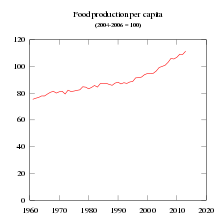
Peak wheat is the concept that agricultural production, due to its high use of water and energy inputs,[119] is subject to the same profile as oil and other fossil fuel production.[120][121][122] The central tenet is that a point is reached, the "peak", beyond which agricultural production plateaus and does not grow any further,[123] and may even go into permanent decline.
Based on current
Agronomy
Growing wheat
Wheat is an
The farmer may intervene while the crop is growing to add
Crop development

Wheat normally needs between 110 and 130 days between sowing and harvest, depending upon climate, seed type, and soil conditions. Optimal crop management requires that the farmer have a detailed understanding of each stage of development in the growing plants. In particular, spring
-
Anthesis stage
-
Late milk stage
-
Right before harvest
Farming techniques
Technological advances in soil preparation and seed placement at planting time, use of crop rotation and fertilizers to improve plant growth, and advances in harvesting methods have all combined to promote wheat as a viable crop. When the use of seed drills replaced broadcasting sowing of seed in the 18th century, another great increase in productivity occurred. Yields of pure wheat per unit area increased as methods of crop rotation were applied to land that had long been in cultivation, and the use of fertilizers became widespread.[132]
Improved agricultural husbandry has more recently included pervasive
In addition to gaps in farming system technology and knowledge, some large wheat grain-producing countries have significant losses after harvest at the farm and because of poor roads, inadequate storage technologies, inefficient supply chains and farmers' inability to bring the produce into retail markets dominated by small shopkeepers. Some 10% of total wheat production is lost at farm level, another 10% is lost because of poor storage and road networks, and additional amounts are lost at the retail level.[138]
In the
-
Field ready for harvesting
-
Combine harvester cuts the wheat stems, threshes the wheat, crushes the chaff and blows it across the field, and loads the grain onto a tractor trailer.
Pests and diseases
Pests[142] – or pests and diseases, depending on the definition – consume 21.47% of the world's wheat crop annually.[143]
Diseases

There are many wheat diseases, mainly caused by fungi, bacteria, and
The main wheat-disease categories are:
- Seed-borne diseases: these include seed-borne scab, seed-borne Stagonospora (previously known as Septoria), common bunt (stinking smut), and loose smut. These are managed with fungicides.[147]
- Leaf- and head-
- Crown and root rot diseases: Two of the more important of these are 'take-all' and Cephalosporium stripe. Both of these diseases are soil borne.[147]
- Stem rust diseases: Caused by Puccinia graminis f. sp. tritici (basidiomycete) fungi e.g. Ug99[149]
- Wheat blast: Caused by Magnaporthe oryzae Triticum.[150]
- Viral diseases: Wheat spindle streak mosaic (yellow mosaic) and barley yellow dwarf are the two most common viral diseases. Control can be achieved by using resistant varieties.[147]
A historically significant disease of cereals including wheat, though commoner in rye is ergot; it is unusual among plant diseases in also causing sickness in humans who ate grain contaminated with the fungus involved, Claviceps purpurea.[151]
Animal pests
Among insect pests of wheat is the
Breeding objectives
In traditional agricultural systems, wheat populations consist of
Major breeding objectives include high
Pathogens and wheat are in a constant process of
For higher yields

The presence of certain versions of wheat genes has been important for crop yields. Genes for the 'dwarfing' trait, first used by Japanese wheat breeders to produce Norin 10 short-stalked wheat, have had a huge effect on wheat yields worldwide, and were major factors in the success of the Green Revolution in Mexico and Asia, an initiative led by Norman Borlaug.[163] Dwarfing genes enable the carbon that is fixed in the plant during photosynthesis to be diverted towards seed production, and they also help prevent the problem of lodging.[164] "Lodging" occurs when an ear stalk falls over in the wind and rots on the ground, and heavy nitrogenous fertilization of wheat makes the grass grow taller and become more susceptible to this problem.[165] By 1997, 81% of the developing world's wheat area was planted to semi-dwarf wheats, giving both increased yields and better response to nitrogenous fertilizer.[166]
The world record wheat yield is about 17 tonnes per hectare (15,000 pounds per acre), reached in New Zealand in 2017.[168] A project in the UK, led by Rothamsted Research has aimed to raise wheat yields in the country to 20 t/ha (18,000 lb/acre) by 2020, but in 2018 the UK record stood at 16 t/ha (14,000 lb/acre), and the average yield was just 8 t/ha (7,100 lb/acre).[169][170]
For disease resistance

Wild grasses in the genus Triticum and related genera, and grasses such as
- Lr67 is an
- Lr34 is widely deployed in cultivars due to its abnormally broad effectiveness, conferring resistance against adult resistance phenotype.[178]
- Pm8 is a widely used 1R chromosome, a source of many resistances since the 1960s.[179]
In 2003 the first resistance genes against fungal diseases in wheat were isolated.[181][182] In 2021, novel resistance genes were identified in wheat against powdery mildew and wheat leaf rust.[183][184] Modified resistance genes have been tested in transgenic wheat and barley plants.[185]
To create hybrid vigor
Because wheat self-pollinates, creating hybrid seed to provide the possible benefits of heterosis, hybrid vigor (as in the familiar F1 hybrids of maize), is extremely labor-intensive; the high cost of hybrid wheat seed relative to its moderate benefits have kept farmers from adopting them widely[186][187] despite nearly 90 years of effort.[188][156] Commercial hybrid wheat seed has been produced using chemical hybridizing agents, plant growth regulators that selectively interfere with pollen development, or naturally occurring cytoplasmic male sterility systems. Hybrid wheat has been a limited commercial success in Europe (particularly France), the United States and South Africa.[189]
Synthetic hexaploids made by crossing the wild goatgrass wheat ancestor Aegilops tauschii,[190] and other Aegilops,[191] and various durum wheats are now being deployed, and these increase the genetic diversity of cultivated wheats.[192][193][194]
For gluten content
Modern bread wheat varieties have been
For water efficiency
Stomata (or leaf pores) are involved in both uptake of carbon dioxide gas from the atmosphere and water vapor losses from the leaf due to water transpiration. Basic physiological investigation of these gas exchange processes has yielded carbon isotope based method used for breeding wheat varieties with improved water-use efficiency. These varieties can improve crop productivity in rain-fed dry-land wheat farms.[198]
For insect resistance
The gene Sm1 protects against the
Genomics
Decoding the genome
In 2010, 95% of the genome of Chinese Spring line 42 wheat was decoded.[203] This genome was released in a basic format for scientists and plant breeders to use but was not fully annotated.[204] In 2012, an essentially complete gene set of bread wheat was published.[205] Random shotgun libraries of total DNA and cDNA from the T. aestivum cv. Chinese Spring (CS42) were sequenced to generate 85 Gb of sequence (220 million reads) and identified between 94,000 and 96,000 genes.[205] In 2018, a more complete Chinese Spring genome was released by a different team.[206] In 2020, 15 genome sequences from various locations and varieties around the world were reported, with examples of their own use of the sequences to localize particular insect and disease resistance factors.[201] Wheat Blast Resistance is controlled by R genes which are highly race-specific.[150]
Genetic engineering
For decades, the primary
- To intentionally damage three male sterility trait, by Li et al. 2020[207]
- Triticum aestivum MLO (TaMLO) genes)[207]
- Triticum aestivum EDR1 (TaEDR1) (the EDR1 gene, which inhibits Bmt resistance) has been knocked out by Zhang et al. 2017 to improve that resistance[207]
- Triticum aestivum HRC (TaHRC) has been disabled by Su et al. 2019 thus producing Gibberella zeae resistance.[207]
- Triticum aestivum Ms1 (TaMs1) has been knocked out by Okada et al. 2019 to produce another novel male sterility[207]
- and ACCase inhibitors respectively[207]
As of 2021[update] these examples illustrate the rapid deployment and results that CRISPR/Cas9 has shown in wheat disease resistance improvement.[207]
In art
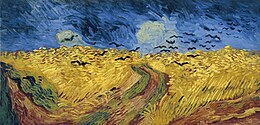
The Dutch artist Vincent van Gogh created the series Wheat Fields between 1885 and 1890, consisting of dozens of paintings made mostly in different parts of rural France. They depict wheat crops, sometimes with farm workers, in varied seasons and styles, sometimes green, sometimes at harvest. Wheatfield with Crows was one of his last paintings, and is considered to be among his greatest works.[208][209]
In 1967, the American artist Thomas Hart Benton made his oil on wood painting Wheat, showing a row of uncut wheat plants, occupying almost the whole height of the painting, between rows of freshly-cut stubble. The painting is held by the Smithsonian American Art Museum.[210]
In 1982, the American conceptual artist
See also
References
- ^ lectotype designated by Duistermaat, Blumea 32: 174 (1987)
- ^ Serial No. 42236 ITIS 2002-09-22
- ^ "triticum". Merriam-Webster.com Dictionary.
- ^ "wheat (plant)". britannica.com. Retrieved 23 December 2023.
- ^ "Fertilising for High Yield and Quality – Cereals" (PDF).
- JSTOR 23786279.
- ISBN 978-94-010-8449-9.
- JSTOR 23783891.
- PMID 23918960.
- ^ a b "Wheat Growth Guide" (PDF). Agriculture and Horticulture Development Board.
- ISBN 9789387741287.
- PMID 16664718.
- PMID 26322065.
- doi:10.1071/FP09121.
- PMID 26976817.
- .
- PMID 30584094.
- S2CID 161961145.
- S2CID 4431395.
- .
- S2CID 56437102.
- PMID 30868647.
- S2CID 5738581.
- S2CID 205216444.
- ^ ISBN 978-0-19-954906-1.
- ^ PMID 12270906.
- doi:10.1560/IJPS.55.3-4.207 (inactive 21 March 2024). Archived from the original on 6 December 2013. Retrieved 6 July 2011.)
{{cite journal}}: CS1 maint: DOI inactive as of March 2024 (link - ISBN 978-1-59874-988-5.
- S2CID 36096777.
- S2CID 225168770.
- ^ S2CID 258044557.
- S2CID 249313666.
- .
- ISBN 978-0-3002-3168-7. Retrieved 19 March 2023.
The general problem with farming — especially plough agriculture — is that it involves so much intensive labor. One form of agriculture, however, eliminates most of this labor: 'flood-retreat' (also known as décrue or recession) agriculture. In flood-retreat agriculture, seeds are generally broadcast on the fertile silt deposited by an annual riverine flood.
- ISBN 978-0-241-40242-9.
- .
- ^ .
- .
- PMID 30012614.
- S2CID 41734442.
- doi:10.5334/ai-391.
- ISBN 978-0-241-40242-9.
- PMID 22566638.
- S2CID 129727157.
- ISBN 978-0-099-30278-0.
- ^ Direct quotation: Grundas, S.T.: Chapter: "Wheat: The Crop", in Encyclopedia of Food Sciences and Nutrition p. 6130, 2003; Elsevier Science
- ^ Piotrowski, Jan (26 February 2019). "Britons may have imported wheat long before farming it". New Scientist. Retrieved 4 June 2020.
- S2CID 1167101.
- PMID 30988490.
Neolithic cultures first appear in Britain circa 4000 bc, a millennium after they appeared in adjacent areas of continental Europe.
- S2CID 19156382.
- PMID 26998604.
- ^ "The science in detail – Wheats DNA – Research – Archaeology". The University of Sheffield. 19 July 2011. Retrieved 27 May 2012.
- ISBN 0-7923-6383-3.
- ISBN 1-85573-553-9.
- ISBN 978-0-226-69710-9.
- ISBN 978-1-5416-4646-9.
- ^ S2CID 39102602.
- ^ ISBN 978-0-7923-6383-5.
- S2CID 13010134.
- PMID 22378960.
- PMID 19386614.
- S2CID 129138746
- ^ PMID 35216323.
- ^ Smithers, Rebecca (15 May 2014). "Spelt flour 'wonder grain' set for a price hike as supplies run low". The Guardian.
- ^ "Triticum turgidum subsp. dicoccon". Germplasm Resources Information Network. Agricultural Research Service, United States Department of Agriculture. Retrieved 11 December 2017.
- S2CID 86510231.
- ^ Anderson, Patricia C. (1991). "Harvesting of Wild Cereals During the Natufian as seen from Experimental Cultivation and Harvest of Wild Einkorn Wheat and Microwear Analysis of Stone Tools". In Bar-Yosef, Ofer (ed.). Natufian Culture in the Levant. International Monographs in Prehistory. Ann Arbor, Michigan: Berghahn Books. p. 523.
- ^ ISBN 0-8014-3339-8.
- ISBN 3-540-41750-8.
- ISBN 0-19-850459-4.
- ^ "Field Crop Information". College of Agriculture and Bioresources, University of Saskatchewan. Archived from the original on 18 October 2023. Retrieved 10 July 2023.
- ^ Bridgwater, W. & Beatrice Aldrich. (1966) "Wheat". The Columbia-Viking Desk Encyclopedia. Columbia University. p. 1959.
- ^ a b c d e f g "Flour types: Wheat, Rye, and Barley". The New York Times. 18 February 1981.
- ^ a b c d e f g "Wheat: Background". USDA. Retrieved 2 October 2016.
- .
- ^ "Marquis Wheat". The Canadian Encyclopedia.
- ^ United States Food and Drug Administration (2024). "Daily Value on the Nutrition and Supplement Facts Labels". Retrieved 28 March 2024.
- )
- ISBN 978-1-4496-4884-8.
Perhaps the simplest of fruits are those of grasses (all cereals such as corn and wheat)...These fruits are caryopses.
- ISBN 978-0-8493-8980-1.
- ^ "Wheat". Food Allergy Canada. Retrieved 25 February 2019.
- ^ PMID 11911770.
- ^ a b "Whole Grain Fact Sheet". European Food Information Council. 1 January 2009. Archived from the original on 20 December 2016. Retrieved 6 December 2016.
- ^ PMID 27610232.
- Community Research and Development Information Service (24 February 2016). "Genetic markers signal increased crop productivity potential". Retrieved 1 June 2017.
- ISBN 978-92-5-107417-6. Archived(PDF) from the original on 9 October 2022. Retrieved 1 June 2017.
- PMID 26175489.
- ^ Shewry, Peter R. "Impacts of agriculture on human health and nutrition – Vol. II – Improving the Protein Content and Quality of Temperate Cereals: Wheat, Barley and Rye" (PDF). UNESCO – Encyclopedia Life Support Systems (UNESCO-EOLSS). Archived (PDF) from the original on 9 October 2022. Retrieved 2 June 2017.
When compared with the WHO requirements of essential amino acids for humans, wheat, barley and rye are seen to be deficient in lysine, with threonine being the second limiting amino acid (Table 1).
- ^ Vasal, S. K. "The role of high lysine cereals in animal and human nutrition in Asia". Food and Agriculture Organization of the United Nations. Retrieved 1 June 2017.
- ^ "Nutritional quality of cereals". Food and Agriculture Organization of the United Nations. Retrieved 1 June 2017.
- PMID 19386614.
- ^ "Whole Grain Resource for the National School Lunch and School Breakfast Programs: A Guide to Meeting the Whole Grain-Rich criteria" (PDF). US Department of Agriculture, Food and Nutrition Service. January 2014. Archived (PDF) from the original on 9 October 2022.
Additionally, menu planners are encouraged to serve a variety of foods that meet whole grain-rich criteria and may not serve the same product every day to count for the HUSSC whole grain-rich criteria.
- ^ "All About the Grains Group". US Department of Agriculture, MyPlate. 2016. Retrieved 6 December 2016.
- ^ a b c d "Celiac disease". World Gastroenterology Organisation Global Guidelines. July 2016. Retrieved 7 December 2016.
- ^ a b c "Definition and Facts for Celiac Disease". The National Institute of Diabetes and Digestive and Kidney Diseases, National Institutes of Health, US Department of Health and Human Services, Bethesda, MD. 2016. Retrieved 5 December 2016.
- ^ PMID 22345659.
- S2CID 207050854.
- PMID 30711208.
- ^ PMID 29337156.
- ^ PMID 25583468.
- PMID 25387079.
- ^ "FAOSTAT". www.fao.org. Retrieved 11 April 2024.
- S2CID 240163091.
- ^ "Wheat production in 2022 from pick lists: Crops/World regions/Production quantity/Year". www.fao.org. Retrieved 11 April 2024.
- ^ "Crops and livestock products". UN Food and Agriculture Organization, Statistics Division, FAOSTAT. 2021. Retrieved 18 April 2021.
- ^ "Wheat area harvested, world total from pick lists: Crops/World regions/Area harvested/Year". 2023. Retrieved 5 October 2023.
- ^ Curtis; Rajaraman; MacPherson (2002). "Bread Wheat". Food and Agriculture Organization of the United Nations.
- .
- ^ "Wheat prices in England". Our World in Data. Retrieved 5 March 2020.
- ^ Palmer, Alan (1996). Dictionary of the British Empire and Commonwealth. pp. 193, 320, 338.
- ^ Ridley, Annie E. (1904). A Backward Glance: The Story of John Ridley, a Pioneer. J. Clarke. p. 21.
- .
- S2CID 38596433.
- ISBN 978-0-226-69710-9.
- ISBN 978-0-226-69710-9.
- ISBN 1-56022-874-1.
- ISBN 9780763715861.
- (PDF) from the original on 9 October 2022.
- ^ IFDC, World Fertilizer Prices Soar, "Archived copy" (PDF). Archived from the original (PDF) on 9 May 2008. Retrieved 3 March 2009.
{{cite web}}: CS1 maint: archived copy as title (link) - ^ "Investing In Agriculture - Food, Feed & Fuel", Feb 29th 2008 at
- ^ "Could we really run out of food?", Jon Markman, March 6, 2008 at http://articles.moneycentral.msn.com/Investing/SuperModels/CouldWeReallyRunOutOfFood.aspx Archived 2011-07-17 at the Wayback Machine
- ^ McKillop, Andrew (13 December 2006). "Peak Natural Gas is On the Way - Raise the Hammer". www.raisethehammer.org. Retrieved 15 September 2022.
- ^ Agcapita Farmland Investment Partnership - Peak oil v. Peak Wheat, July 1, 2008, "Archived copy" (PDF). Archived from the original (PDF) on 20 March 2009. Retrieved 24 July 2008.
{{cite web}}: CS1 maint: archived copy as title (link) - ^ "The future of food and agriculture: Trends and challenges" (PDF).
- ^ Globe Investor at http://www.globeinvestor.com/servlet/WireFeedRedirect?cf=GlobeInvestor/config&date=20080408&archive=nlk&slug=00011064
- ^ Credit Suisse First Boston, Higher Agricultural Prices: Opportunities and Risks, November 2007
- ^ Food Production May Have to Double by 2030 - Western Spectator "Food Prices Could Increase 10 Times by 2050 | WS". Archived from the original on 3 October 2009. Retrieved 9 October 2009.
- ^ Agriculture and Food — Agricultural Production Indices: Food production per capita index Archived 2009-07-22 at the Wayback Machine, World Resources Institute
- ^ a b "How To Grow Wheat Efficiently On A Large Farm". EOS Data Analytics. 10 May 2023. Retrieved 23 December 2023.
- ISBN 1-56022-874-1.
- .
- ISBN 978-0-521-56859-3.
- S2CID 234622559.
- ISBN 0-309-08908-5.
- PMID 15829727.
- ^ Shindler, Miriam (3 January 2016). "From east Asia to south Asia, via Mexico: how one gene changed the course of history". CIMMYT. Retrieved 19 November 2021.
- PMID 4918766.
- ^ Basavaraja, H.; Mahajanashetti, S.B.; Udagatti, N.C. (2007). "Economic Analysis of Post-harvest Losses in Food Grains in India: A Case Study of Karnataka" (PDF). Agricultural Economics Research Review. 20: 117–126. Archived (PDF) from the original on 9 October 2022.
- PMID 20110467.
- ^ Swaminathan, M. S. (2004). "Stocktake on cropping and crop science for a diverse planet". Proceedings of the 4th International Crop Science Congress, Brisbane, Australia.
- ^ "Umbers, Alan (2006, Grains Council of Australia Limited) Grains Industry trends in Production – Results from Today's Farming Practices" (PDF). Archived from the original (PDF) on 26 January 2017.
- ^ "Pest Management". American Society of Agronomy. 7 March 2018. Retrieved 31 January 2021.
- S2CID 59603871.
- ^ Abhishek, Aditya (11 January 2021). "Disease of Wheat: Get To Know Everything About Wheat Diseases". Agriculture Review. Archived from the original on 24 January 2021. Retrieved 29 January 2021.
- ^ "G4319 Wheat Diseases in Missouri, MU Extension". University of Missouri Extension. Archived from the original on 27 February 2007. Retrieved 18 May 2009.
- ^ C.Michael Hogan. 2013. Wheat. Encyclopedia of Earth, National Council for Science and the Environment, Washington DC ed. P. Saundry
- ^ PMID 36714765.
- S2CID 16596348.
- ISBN 9780123743558. Archived from the originalon 8 November 2020. Retrieved 4 October 2023.
- ^ S2CID 235049332.
- ^ Harveson, Bob (17 August 2017). "Has Ergot Altered Events in World History?". Cropwatch. unl.edu.
- S2CID 86001776.
- ^ Biological Control of Stored-Product Pests. Biological Control News Volume II, Number 10 October 1995 Archived 15 June 2010 at the Wayback Machine
- ^ CSIRO Rodent Management Research Focus: Mice plagues Archived 21 July 2010 at the Wayback Machine
- ^ "ARS, Industry Cooperation Yields Device to Detect Insects in Stored Wheat". USDA Agricultural Research Service. 24 June 2010.
- ^ ISBN 3-540-51809-6.
- ^ a b "Mutant variety database". MVGS International Atomic Energy Agency.
- .
- S2CID 10873152.
- ^ MacNeil, Marcia (20 January 2021). "CIMMYT scientist Ravi Singh receives prestigious award from the Government of India". International Maize and Wheat Improvement Center. Retrieved 27 January 2021.
- ^ "Press Release: ICARDA safeguards world heritage of genetic resources during the conflict in Syria". International Center for Agricultural Research in the Dry Areas. Retrieved 27 January 2021.
- ^ PMID 35126650.
- S2CID 30146700.
- S2CID 22243940.
- ISBN 9780120007738.
- S2CID 85738377.
- ^ PMID 34009390.
- ^ "Guinness World Records – Highest Wheat Yield". 10 August 2022.
- ^ Farmers Weekly (23 November 2018). "Lincs grower scoops top wheat and rapeseed yield awards".
- ^ "Agricultural and Horticultural Development Board – 2018 GB Harvest Progress Results".
- PMID 10339521.
- WHEAT. Archived from the originalon 22 September 2021. Retrieved 28 July 2021.
- S2CID 238580339.
- PMID 29382771.
- ^ S2CID 8989912.
- PMID 19229000.
- PMID 30913300.
- ^ PMID 22074787.
- ^ PMID 28559761.
- S2CID 225570977.
- PMID 14645721.
- PMID 14756761.
- PMID 33707738.
- PMID 33574268.
- PMID 38071644.
- ^ Mike Abram for Farmers' Weekly. 17 May 2011. Hybrid wheat to make a return
- ^ Bill Spiegel for agriculture.com 11 March 2013 Hybrid wheat's comeback
- ^ "The Hybrid wheat website". 18 December 2013. Archived from the original on 18 December 2013.
- ISBN 1-56022-876-8.
- S2CID 219730099.
- PMID 31143197.
- ^ (12 May 2013) Cambridge-based scientists develop 'superwheat' BBC News UK, Retrieved 25 May 2013
- ^ Synthetic hexaploids Archived 28 November 2011 at the Wayback Machine
- ^ (2013) Synthetic hexaploid wheat Archived 16 April 2014 at the Wayback Machine UK National Institute of Agricultural Botany, Retrieved 25 May 2013
- S2CID 46259398.
- PMID 22224557.

- S2CID 220469138.
- .
- S2CID 14168477.
- ^ Ahmad, Reaz (26 November 2020). "New genome sequencing rekindles hope for fighting wheat blast". Dhaka Tribune. Retrieved 22 December 2020.
- ^ a b "Landmark study generates first genomic atlas for global wheat improvement". University of Saskatchewan. 25 November 2020. Retrieved 22 December 2020.
- PMID 33239791.
- ^ "UK researchers release draft sequence coverage of wheat genome". Biotechnology and Biological Sciences Research Council. 27 August 2010. Archived from the original on 11 June 2011.
- ^ "UK scientists publish draft sequence coverage of wheat genome" (PDF). Biotechnology and Biological Sciences Research Council. Archived (PDF) from the original on 15 July 2011. Retrieved 15 July 2011.
- ^ PMID 23192148.
- ^ "U of S crop scientists help crack the wheat genome code". University of Saskatchewan, Canada. 16 August 2018. Retrieved 22 December 2020.
- ^ PMID 34327324.
- ISBN 1588391957.
- ISBN 978-1137526618.
- ^ "Wheat". Smithsonian Institution. Retrieved 28 January 2024.
- ^ Hessel, Katy (18 July 2022). "A field of wheat on a $4.5bn patch of New York: the prophetic eco art of Agnes Denes". The Guardian. Retrieved 28 January 2024.
Further reading
- The World Wheat Book : A History of Wheat Breeding
- Bonjean, Alain P.; Angus, William J. (2001). The World Wheat Book : A History of Wheat Breeding. Vol. 1. OCLC 59515318.
- Bonjean, Alain P. (2011). The World Wheat Book : A History of Wheat Breeding. Vol. 2. OCLC 707171112.
- Bonjean, Alain P.; Angus, William J.; Ginkel, Maarten van (2016). The World Wheat Book : A History of Wheat Breeding. Vol. 3. OCLC 953081390.
- Bonjean, Alain P.; Angus, William J. (2001). The World Wheat Book : A History of Wheat Breeding. Vol. 1.
- Head, Lesley; Atchison, Jennifer; Gates, Alison (2016). Ingrained: A Human Bio-geography of Wheat. OCLC 1082225627.
- Jasny Naum, The Wheats of Classical Antiquity. S2CID 82345748.
- Nelson, Scott Reynolds (2022). Oceans of Grain: How American Wheat Remade the World. Excerpt.
- Shiferaw, Bekele; Smale, Melinda; Braun, Hans-Joachim; Duveiller, Etienne; Reynolds, Mathew; Muricho, Geoffrey (2013). "Crops that feed the world 10. Past successes and future challenges to the role played by wheat in global food security". Food Security. 5 (3): 291–317. .
External links
 Media related to Wheat at Wikimedia Commons
Media related to Wheat at Wikimedia Commons- Triticum species at Purdue University


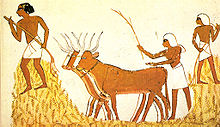
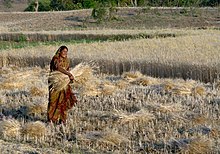
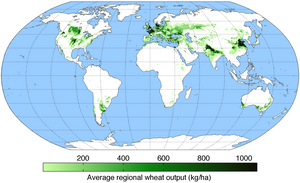
![Production of wheat (2019)[103]](http://upload.wikimedia.org/wikipedia/commons/thumb/e/e5/Production_of_wheat_%282019%29.svg/300px-Production_of_wheat_%282019%29.svg.png)


